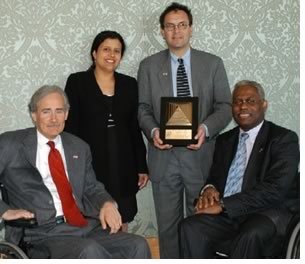

Bell Receives Barrier-Free America Award
The Paralyzed Veterans of America (PVA), a national veterans’ service and disability rights organization, honored AIA New York Chapter Executive Director Fredric Bell, FAIA, with its 2004 Barrier-Free America Award April 16 during a ceremony in Battery Park in Lower Manhattan. The honor recognizes Bell’s efforts to make accessibility a part of the redevelopment program for Lower Manhattan and his ongoing advocacy for universal design in New York City.
 Michael
Arad, AIA, designer of the World Trade Center Memorial, joined the many
city officials and universal design advocates who effusively described
Bell’s many accomplishments, both as a city commissioner of design
and construction and as a partner at the AIA New York Chapter. PVA co-hosted
the event with the New York Mayor’s Office for People with Disabilities.
Michael
Arad, AIA, designer of the World Trade Center Memorial, joined the many
city officials and universal design advocates who effusively described
Bell’s many accomplishments, both as a city commissioner of design
and construction and as a partner at the AIA New York Chapter. PVA co-hosted
the event with the New York Mayor’s Office for People with Disabilities.
“Having the privilege to work for design excellence and universal design with many talented colleagues in New York City, at MOPD, at the NYC Department of Design and Construction, and now at the American Institute of Architects New York Chapter, allows me to accept the award with humility, recognizing that all significant change in design standards and building codes can only come about through concerted and collaborative action,” Bell said. New York City Mayor Michael Bloomberg and PVA National President Joseph L. Fox Sr. both expressed their appreciation for Bell’s contributions. “It is through the work of individuals like Rick Bell that we not only create a greater understanding for the everyday challenges facing the disability community, but, more importantly, provide the accessible solutions to these challenges,” Fox said.
Accessibility at the World Trade Center
site
“Accessibility was brought into the discussion for the World Trade
Center site planning from the beginning,” Bell said. He pointed
to preliminary programs established by LMDC, the Memorial Program Guiding
Principles, and the work of the design and planning coalitions, including
New York New Visions, which continually stressed issues of access, connectivity,
and the interconnection of transportation infrastructure and accessibility.
He said the final proposals for the World Trade Center site addressed
these concerns.
 “Access
issues to bedrock-level memorial spaces were particularly addressed in
the long slurry-wall ramp in the memorial setting proposed by Studio Daniel
Libeskind. Similarly, the winning memorial scheme by Michael Arad and
Peter Walker fundamentally addresses universal access to the tower footprints
by means of ramps that define the edges and locations of the original
Twin Towers,” Bell noted. Discussions at New York New Visions are
leading to “discrete changes to improve and equalize accessibility.”
He expects the process and the resulting design to serve as a model for
other projects in New York and elsewhere.
“Access
issues to bedrock-level memorial spaces were particularly addressed in
the long slurry-wall ramp in the memorial setting proposed by Studio Daniel
Libeskind. Similarly, the winning memorial scheme by Michael Arad and
Peter Walker fundamentally addresses universal access to the tower footprints
by means of ramps that define the edges and locations of the original
Twin Towers,” Bell noted. Discussions at New York New Visions are
leading to “discrete changes to improve and equalize accessibility.”
He expects the process and the resulting design to serve as a model for
other projects in New York and elsewhere.
Real solutions
“The hardest thing to get people and city agencies to understand
and agree upon is the necessity for clear and strong building code language
that doesn’t simply rely upon or refer to ADA and, in New York City,
Local Law 58, the Universal Design Guidelines, and the New York City Department
of Design and Construction,” Bell said. He notes that a committee
is “midway in its task to bring focused and improved language to
the revised version of the International Building Code, likely to be adopted
as a replacement to the confusing and archaic New York City Building Code.”
The New York City Department of Parks and Recreation used the ceremony to highlight 13 new parks that would incorporate the principles of universal design, including wider and smoother paths, usable benches, and parks that can be experienced in different ways, for example by incorporating taller flowers so people do not have to bend to reach them.
“Architects and clients have to learn the value of doing more than is required, of exceeding expectations to incrementally achieve a better and more accessible environment,” Bell said. At the ceremony, he noted, “We cannot bring back the lives lost on September 11. We cannot bring back the heroes who have died fighting tyranny across the globe. We can bring to bear the basic rights of dignity, equality, and access. We can change the building code to make buildings safer and easier to exit. We can assure that 10 million stories of accessibility and design excellence are told to every town and nation around the world.”
Copyright 2004 The American Institute of Architects.
All rights reserved. Home Page ![]()
![]()
